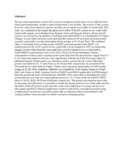Effect Of Lactoperoxidase-Thiocyanate-Hydrogen Peroxide System And Storage Temperature On Keeping Quality Of Raw Camel Milk

View/
Date
2010-10Author
Kamau, P M N
Lamuka, P O
Wango, J
Type
ArticleLanguage
enMetadata
Show full item recordAbstract
The use of lactoperoxidase system (LP-system) in temporary preservation of raw milk
has been found useful particularly in places where refrigeration is not feasible. The
activity of this system, however, varies from species to species and there are no
reports on its effect in camel milk. This study was conducted to investigate the
preservative effect of the LP-system on raw camel milk. Camel milk samples were
obtained from Kajiado, Isiolo and Nanyuki districts, Kenya and LP-system was
activated by the addition of hydrogen peroxide (H2O2) to a concentration of 8.5ppm
Changes in total viable bacterial counts and titratable acidity in LP-activated and nonactivated
(control) camel milk were then determined during storage at 10, 20 and
30oC. The combined effect of increasing levels of thiocyanate (NaSCN) and hydrogen
peroxide (H2O2 ) on antibacterial activity of LP-system in raw camel milk was
investigated at 30ºC by monitoring changes in total viable bacterial counts and lactic
acid development in raw camel milk at NaSCN:H2O2 concentrations ratios of 0, 10:10,
20:20, 30:30 and 40:40ppms. Natural concentration of thiocyanate occurring in the
camel milk from the three districts ranged from 9.7 to 36.4 mg/l and respective
districts were significantly different (p<0.05) from each other. No additional amount
of thiocyanate was, therefore, used to activate the LP-system. Microbial growth was
halted for 15, 17 and 76 hrs at 30, 20 and 10oC, respectively by activation of the LPsystem
in raw camel milk at 8.5ppm. Viable counts increased significantly (p<0.05)
during storage at 10, 20, 30oC conditions. Shelflife was extended by 19 hrs during
storage at 10 and 20oC and 4 hours at 30oC. Increased levels of NaSCN and H2O2
significantly (p<0.05)delayed bacterial growth and lactic acid production. Shelflife of
the camel milk as determined by lactic acid production was 4 hrs for control and
increased to 6, 12, 16 and 16 hrs for NaSCN: H2O2 ratios of 10:10, 20:20, 30:30 and
40:40 ppm, respectively. The present investigation shows that by activating the LPSystem,
it is possible to extend the storage period of raw camel milk and that the
effect of the LP-System on the microbes varies with temperature of storage and levels
of thiocyanate and H2O2. Practical application would be achieved by controlled
activation using commercial LP-system kits for pooled camel milk at collection
centers and combined with cooling facilities where possible for further extension of
keeping quality
Citation
African Journal of Food Agriculture Nutrition and DevelopmentPublisher
Department of Food Science, Nutrition and Technology, University of Nairobi
Description
Journal article
